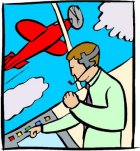
Worksheets and No Prep Teaching Resources
Reading Comprehension Worksheets
Transportation

Transportation
 Worksheets and No Prep Teaching Resources Reading Comprehension Worksheets Transportation |
 Transportation |
| edHelper's suggested reading level: | grades 5 to 7 | |
| Flesch-Kincaid grade level: | 10.14 |
|
Air Navigation, Part 1
By Trista L. Pollard |

|
 1 Just as a driver needs a map when traveling to a new destination, airline pilots need a system for transporting people safely. That's where air navigation comes into the picture. Air navigation is the science and technology that is used to determine an aircraft's position with respect to the earth's surface. It also helps pilots maintain the aircraft's course (direction of travel), and the aircraft to be monitored or watched as it travels to its destination.
1 Just as a driver needs a map when traveling to a new destination, airline pilots need a system for transporting people safely. That's where air navigation comes into the picture. Air navigation is the science and technology that is used to determine an aircraft's position with respect to the earth's surface. It also helps pilots maintain the aircraft's course (direction of travel), and the aircraft to be monitored or watched as it travels to its destination. |
Create Weekly Reading Books
Prepare for an entire week at once! |
| Leave your feedback on Air Navigation, Part 1 (use this link if you found an error in the story) |
 |
Transportation
|